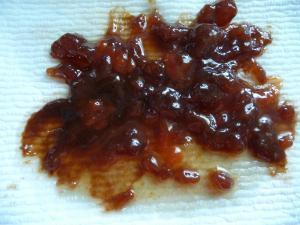Hemorrhagic Gastroenteritis in Dogs
- posted: Mar. 25, 2018
 What the Heck Is HGE?
What the Heck Is HGE?
HGE or Hemorrhagic Gastroenteritis syndrome, (recently renamed Acute Hemorrhagic Diarrhea Syndrome, AHDS for short) is not only a huge mouthful to say, but a potentially serious condition affecting dogs. So, what exactly is AHDS? Turns out, despite numerous research studies, no one really knows what causes this syndrome. It most commonly affects middle-aged small breed dogs, though any breed can be affected. The symptoms include lethargy, a high red blood cell count and bloody diarrhea with mucus often described as looking like raspberry jam. Occasionally vomiting and abdominal pain may be reported.
The true cause of AHDS is unknown. The most common theory is that a type of bacteria called Clostridium is responsible for the symptoms; however, Clostridium is a normal part of the bacteria that colonize the colon, so it is not truly known if this bacteria is the cause or if Clostridium is found in increased numbers in cases of AHDS due to other reasons. E. coli bacteria could also be a potential cause, but studies showing a true link are lacking. Another theory is that AHDS may be caused by an immune-mediated reaction to cells in the intestine causing damage to the intestinal lining and leading to diarrhea.
Diagnosis is based on clinical signs and your veterinarian will usually run a quick test to check your pet’s red blood cell count as well. Other blood tests or x-rays may be recommended to rule out other causes of illness. Regardless of the cause, patients exhibiting signs of bloody diarrhea and a high red blood cell count are typically treated with intravenous fluids to correct the concentrated blood cells and combat dehydration. Patients are also usually given either IV or oral antibiotics. Most dogs improve within one to two days. Cases that do not exhibit extremely high numbers of red blood cells and who are still eating are sometimes treated on an outpatient basis with fluids under the skin, oral antibiotics and occasionally with stomach protectants and/or anti-diarrheal drugs.
The onset of this condition is usually sudden, and the amount of blood can look quite scary, but quick diagnosis and treatment hold a good prognosis for full recovery. Symptoms do occasionally recur in affected dogs. If your dog has jelly-like bloody stools, please contact your veterinarian as soon as possible so he or she can receive proper treatment.
This blog brought to you by the Patton Veterinary Hospital serving Red Lion, York and the surrounding communities.
Source: Western Veterinary Conference lecture: Hemorrhagic Gastroenteritis: What Exactly is This Disease? Elizabeth Thomovsky, DVM, MS, DACVECC, Purdue University College of Veterinary Medicine
Location
Patton Veterinary Hospital
425 E Broadway
Red Lion, PA 17356
